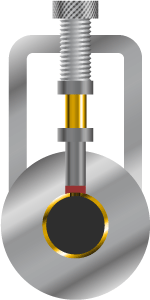- 01: Introduction
- 02: History
- 03: Propellants, Firearms, and Ammunition Development
- 04: Modern Firearms Manufacture
- 05: Small Arms Ammunition
- 06: Evidence Handling Procedures
- 07: Equipment and Instrumentation
- 08: Examination of Firearms
- 09: Cartridge and Shotshell Examination
- 10: Characterization and Evaluation of Fired Projectiles
- 11: Bullet Comparison and Identification
- 12: Gunshot Residue and Distance Determination
- 13: Toolmark Identification
- 14: Communicating Results
- Resources


Pressure
Home > Small Arms Ammunition > Ballistic Testing > Pressure

Copper crusher apparatus
Click for larger imageThe most important factor in testing newly manufactured ammunition is to ensure that the pressure generated at firing does not exceed the standards.
Crusher testing is an obsolescent method that is still retained for some cartridges for which standards have not been converted to current methods. In this method, the test barrel is placed over the cartridge case and a steel piston touches the case. A soft copper rod (crusher) sits atop the piston and is restrained by an anvil. When the cartridge fires, pressure pierces the case and drives the piston into the copper crusher. This force shortens the crusher and the length is measured. Postfiring lengths are compared to calibration tables accompanying each lot of crushers to find the pressure value for each shot.
In the most commonly used method (piezoelectric transducer testing), cartridges are fired in a barrel fitted with sensors that detect pressure. When compressed, the transducer in the test barrel creates an electrical signal - the greater the pressure, the greater the signal. This method tests ammunition at a rapid rate with a high degree of accuracy.
Compared to transducer testing, crusher testing is extremely slow. Crusher testing provides only a snapshot of maximum pressure; there is no time reference. Transducer testing generates pressure readings over a period of time. If the output of ballistic pressure testing is compared to photography, crusher results are like low-resolution black-and-white snapshots; transducer results are like high-definition digital video clips.




